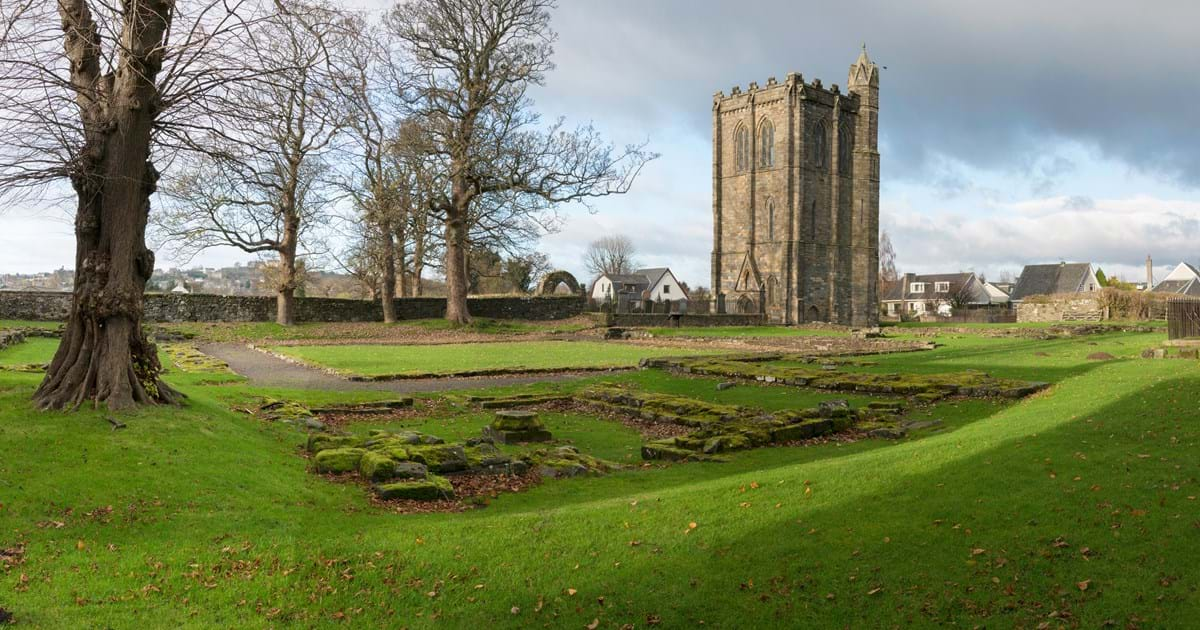Cambuskenneth in Stirlingshire, is located just over the river Forth from the City of Stirling and is a small village with a rich history. Access to this village, situated on a loop of the Forth, by road is via a relatively narrow two-lane road from Causewayhead at the foot of the Abbey Craig, over the railway track and on to the village. By foot you can cross over the Forth from Stirling's Riverside area using the footbridge, opened in October 1935 to replace the previous small passenger ferry crossing which had been the main link to Stirling for centuries.
The current population of Cambuskenneth is around 300, and this is unlikely to change significantly in the foreseeable future, however the village has since expanded. Stirling Council have produced a leaflet on the Cambuskenneth Heritage Trail, which can be accessed here.
Cambuskenneth village owes its existence to the foundation by Scots King David I of an Abbey in 1140, around the remains of which the village is built. Below is a map from around 1899 showing Cambuskenneth in relation to Stirling. Note the ferry crossing is shown.

Despite its close proximity to Stirling, and the village also being in the parish of Stirling, Cambuskenneth and much of the Abbey craig were within the County of Clackmannan. This persisted until the boundary changes of 1891, where Alva became part of Clackmannanshire, and Cambuskenneth became part of Stirlingshire.
Cambuskenneth Abbey
Cambuskenneth Abbey was a monastery and was known throughout Europe. It played an important role during the Scottish wars of independence in the 13th and 14th centuries. Here Robert Bruce held some of the first Scottish parliaments. One of the connected buildings was later named “Parliament Hall”. Robert the Bruce, after his victory in the Battle of Bannockburn in 1314, held a parliament at the Abbey and had the spoils of the war shared on its grounds. The site is relatively little known today.
The Abbey was initially known as the Abbey of St. Mary of Stirling. In 1147 Pope Eugene III declared the Abbey had his protection through a papal bull, a status confirmed by both Pope Alexander III in 1164 and Pope Celestine III in 1195. The abbey became known as Cambuskenneth rather than Stirling from around 1207 as shown by papal bulls of the time. Cambuskenneth means “creek or field of Kenneth”. This may be due to the battle that occurred nearby at Logie where Scots King Kenneth MacAlpin vanquished the Picts.
Around 1140, its construction began by order of King David I. It has been suggested that it was built to serve the Crown as a Royal Abbey. It was the only daughter house of the French Arrouaise Order in Scotland. The Arrouaise also managed other churches and abbeys on land owned by David I. The Arrouaise were a distinct order at the time of the Abbey's construction to the Augustinians but the two orders would later merge.
Patrick Pantar, who became abbot of the abbey in 1513, also served as secretary to King James V and fought at the Battle of Flodden. He is considered one of the most prominent abbots given his political involvement to such an extent.
King James III was killed in the Battle of Sauchieburn in 1488. His wife, Queen Margaret of Denmark died at the Abbey in 1486. The two were buried there. King James’ tomb was completed in 1502 and David Pratt painted it.
The tomb was destroyed when a huge part of the abbey was dismantled following the Reformation in the late 1560s by the then military governor Lord Erskine, Earl of Mar. He used much of its stonework to build his lodgings in Stirling. For this his family was cursed by the Abbot at Alloa Tower.
In 1865, Queen Victoria ordered its restoration. The Bell Tower was reconstructed in 1859 under the directorship of Stirling architect William Mackison. He also uncovered the foundation plans of the abbey and surrounding conventional buildings and had them consolidated. All that is left now is the three-storey bell tower, and the low foundations of the nave, cloister, garth, refectory, chapter house and church, all reconstructed.
At the site of the altar is a monument-memorial erected by Queen Victoria to King James III and his wife Margaret, who were both interred in the Abbey precincts.
With the demise of the Abbey at the Reformation, Cambuskenneth was slow to develop as a village, but the rich fertile soil continued to be farmed, and the famous apple orchards were tended with only a small number of houses being built. The first real expansion was the building of two rows of cottages to house the miners working the coal pit at Manor Powis.
The abbey was acquired by the crown in 1908, and it is managed by Historic Environment Scotland. The Cambuskenneth Abbey is open to the public for visits, especially during summer.

Cambuskenneth Abbey, Picture: Historic Environment Scotland
